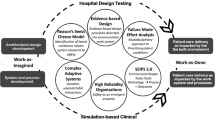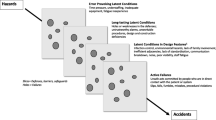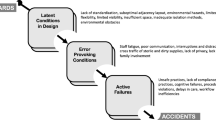Abstract
The healthcare facility design process provides a singular opportunity for designing spaces that promote safe and high-quality care. Virtual and physical full-scale models of spaces, called mock-ups, are increasingly being employed by healthcare architecture firms and health systems while planning for new or remodeled patient care areas. Simulating typical and high risk clinical scenarios in these mock-ups and then evaluating the performance of these spaces in relation to key design objectives, offers huge benefits and cost savings to healthcare teams by hel** identify design challenges before the building is constructed. In addition to cost savings, these simulation-based evaluations are also effective in engaging multidisciplinary clinical stakeholders and obtaining staff buy-in for major design and operational changes.
Access this chapter
Tax calculation will be finalised at checkout
Purchases are for personal use only
Similar content being viewed by others
References
Joseph A, Rashid M. The architecture of safety: hospital design. Curr Opin Crit Care. 2007;13(6):714–9.
Ulrich RS, Zimring C, Zhu X, Dubose J, Seo H-B, Choi Y-S, et al. A review of the research literature on evidence-based healthcare design (Part II). Health Environ Res Des J. 2008;1(Spring):61–125.
Auerbach M, Stone KP, Patterson MD. The role of simulation in improving patient safety. In: Grant VJ, Cheng A, editors. Comprehensive healthcare simulation: pediatrics. Cham: Springer; 2016. p. 55–65.
Stone KP, Huang L, Reid JR, Deutsch ES. Systems integration, human factors and simulation. In: Grant VJ, Cheng A, editors. Comprehensive healthcare simulation: pediatrics. Cham: Springer; 2016. p. 67–75.
Geis GL, Pio B, Pendergrass TL, Moyer MR, Patterson MD. Simulation to assess the safety of new healthcare teams and new facilities. Simul Healthc. 2011;6(3):125–33.
Patterson MD, Geis GL, LeMaster T, Wears RL. Impact of multidisciplinary simulation-based training on patient safety in a paediatric emergency department. BMJ Qual Saf. 2013;22(5):383–93.
Hall KK, Kyriacou D, Handler JA, Adams JG. Impact of emergency department built environment on timeliness of physician assessment of patients with chest pain. Environ Behav. 2008;40(2):233–48.
Anumba CJ, Baron G, Evbuomwan NFO. Communications issues in concurrent life-cycle design and construction. BT Technol J. 1997;15(1):209–16.
Dunston PS, Arns LL, McGlothlin JD. Virtual reality mock-ups for healthcare facility design and a model for technology hub collaboration. J Build Perform Simul. 2010;3(3):185–95.
Traversari R, Goedhart R, Schraagen JM. Process simulation during the design process makes the difference: process simulations applied to a traditional design. HERD. 2013;6(2):58–76.
Peavey EK, Zoss J, Watkins N. Simulation and mock-up research methods to enhance design decision making. HERD. 2012;5(3):133–44.
Watkins N, Kobelja M, Peavey E, Thomas S, Lyon J. An evaluation of operating room safety and efficiency: pilot utilization of a structured focus group format and three-dimensional video mock-up to inform design decision. HERD. 2011;5(1):6–22.
Bayramzadeh S, Joseph A, Allison D, Shultz J, Abernathy J. Using an integrative mock-up simulation approach for evidence-based evaluation of operating room design prototypes. Appl Ergon. 2018;70:288–99.
Health Quality Council of Alberta (HQCA). Simulation-based mock-up evaluation framework. Calgary: Health Quality Council of Alberta; 2016.
Kuliga S, Tyler T, Dalton RC, Hölscher C. Virtual reality as an empirical research tool—exploring user experience in a real building and a corresponding virtual model. Comput Environ Urban Syst. 2015;54:363–75.
Rebelo F, Noriega P, Duarte E, Soares M. Using virtual reality to assess user experience. Hum Factors. 2012;54(6):964–82.
Fulton Suri J, Marsh M. Scenario building as an ergonomics method in consumer product design. Appl Ergon. 2000;31(2):151–7.
Sherwood CH. Architects of innovation. Penn Med Mag. 2018;
Hoppszallern S, Vesely R, Morgan J. 2016 hospital construction survey: patient experience drives design and construction: American Hospital Association (AHA); 2016. [cited 2016 Feb 3]. Available from: https://www.hfmmagazine.com/articles/1878-2016-hospital-construction-survey
Centers for Medicare and Medicaid Services. HCAHPS: patients’ perspective of care survey. Baltimore: Centers for Medicare and Medicaid Services; 2019. [updated 10/15/19. Available from: https://www.cms.gov/Medicare/Quality-Initiatives-Patient-Assessment-Instruments/HospitalQualityInits/HospitalHCAHPS
Author information
Authors and Affiliations
Corresponding author
Editor information
Editors and Affiliations
Rights and permissions
Copyright information
© 2021 Springer Nature Switzerland AG
About this chapter
Cite this chapter
Joseph, A., Reid, J., Kearney, J.J. (2021). Planning Patient Care Areas Using Simulation. In: Deutsch, E.S., Perry, S.J., Gurnaney, H.G. (eds) Comprehensive Healthcare Simulation: Improving Healthcare Systems. Comprehensive Healthcare Simulation. Springer, Cham. https://doi.org/10.1007/978-3-030-72973-8_14
Download citation
DOI: https://doi.org/10.1007/978-3-030-72973-8_14
Published:
Publisher Name: Springer, Cham
Print ISBN: 978-3-030-72972-1
Online ISBN: 978-3-030-72973-8
eBook Packages: MedicineMedicine (R0)




